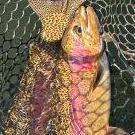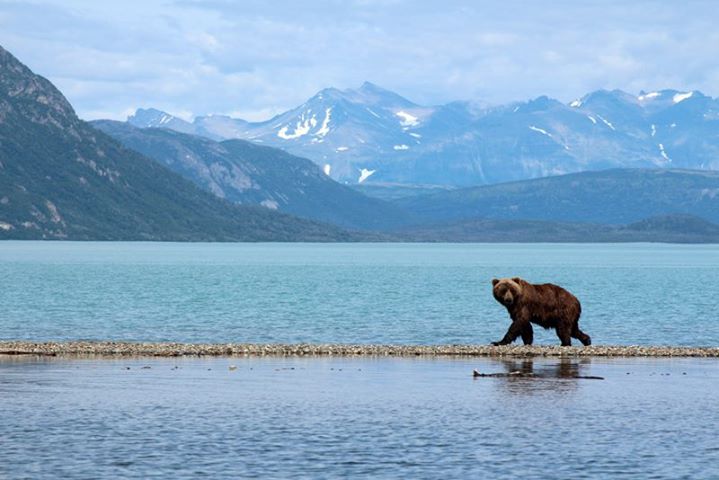-
Posts
18,931 -
Joined
-
Last visited
-
Days Won
123
Content Type
Profiles
Forums
Blogs
Events
Articles
Video Feed
Gallery
Everything posted by Phil Lilley
-
"I live in the beautiful Moutain of Weastern North Carolina land of the Smokies Mountains." Flyfisher - what rivers do you fish?
-
I got out finally at 4 pm today and boated to the dam. Drifted once to the boat ramp using a 3/32 oz brown/orange jig with an orange head. Caught 7 small rainbows. They were running 2 units and the drift was perfect. The wind was slight but enough to be anoying. I boated back up and threw a gray/white 1/8th oz jig this time and got a strike right off at the cable so I tied to the cable in mid stream and threw there for awhile. Missed a dozen strikes, even after trimming the jig. The water had slowed even more and the trout were on the surface chasing midges which were hatching like crazy. I finally stop trying and drifted down throwing a white jig this time and caught another 6-7 rainbows, a couple pushing 15 inches. Nice evening. Heard fishing down to the Branson bridges was very good today, drifting a white and a yellow power egg on the bottom, per Alltec from St Louis. I saw people catching rainbows out in front of the dock this evening as I left the dock- they were drifting bait too.
-
The water isn't running too hard- today it wasn't- and people were catching trout off the dock. So yes there is fairly good fishing off our dock.
-
Table Rock and the dam area. Pea gravel banks in late April and May.
-
It's good to see you're so excited about such a thing as a birthday, especially at 62. That's a very good sign that you are a blessed man. Phil
-
Can you imagine getting an image and description for every item in your shop and then entering it all in a program? Adding the colors for all the dubbing and eyes and beads and sizes and ... it goes on and on. I'm on flies right now- jigs are finally done but I don't like the pics I took so I'll probably do them over.
-
We have lots of openings this weekend (today and tomorrow). Drop me an email if you think you can get away for a night or two and we'll work a deal. There are few weekends, if any more this year, that I can do this. Weekdays are a different thing though. We still offer our $29 per night lodging special for weekdays stays thru Feburary.
-
I would think the Beaver Dam Store do. We will as soon as I get our store online. I posted micro jigs today, photos included. I hope to have the shop up and running within 2 weeks. It's alot of work!!
-
I don't but Bill Babler, Bill Beck or SKMO fish enough they usually give us the temp fairly often.
-
White... shad patterns. Floating is good if they are really running thick. Much more exciting when they hit a topwater shad.
-
There's quite a bit of info if you look back at some old post from last year. http://ozarkanglers.com/forums/index.php?showtopic=625 http://ozarkanglers.com/forums/index.php?showforum=106 Here are a couple of places. I'm no expert at all but rogues seem to be the best. Walleye like any structure and eddies. And they bite best at night.
-
I have a microwave recipe someplace here.
-
Now thru March. And best time is anytime you can get away and go fish! Cloudy, nasty days are best I've found for walleye.
-
http://www.news-leader.com/apps/pbcs.dll/a.../701250317/1037 Here's a story in the Springfield Newsleader this morning... if you read it you might think I said there's shad coming thru the dam here. Well Steve has pick up an old quote from I think a year or may be two ago and it sounds like it's current. Don't think he intended to make it so... just came out that way. Anyhow with all the questions about shad lately, didn't want anyone jumping in their truck and heading down. Tr's temp is down low enough we could see some shad but again, you never know. Good plug for the website.
-
Then you are talking about below the dam at Powersite.
-
Here's what Jim sent today - Winter Address: 10554 South M-37 Baldwin, Mi. 49304 Phone : 231-745-2894 Summer Address: Box 32, Lake Camp King Salmon, Ak. 99613 Phone : 907-246-2894 Alaska’s Naknek River Camp Email us at naknekrivercamp@hotmail.com www.naknekrivercamp.com 2007 Openings June 16th - 23rd 6 openings This is generally low water, easier wading and great rainbow fishing. There will also be an opportunity to catch grayling and dolly varden. The Kings should be moving into the lower reaches of the Naknek. Most of the fishing for kings will be with spinning or conventional tackle. The sockeye run should start sometime during the latter part of this week. June 23rd -30th 4 guests. The river will start coming up as the weather warms and the glaciers up above the lake begin melting. The rainbow and grayling fishing will remain excellent. Kings and sockeye runs will be in full swing. July 14th - 21st 4 openings Cabin #5 in open for a do-it-yourself trip for up to 4 guests. Kings and sockeye fishing will still be rolling. Bear viewing at Brooks is at it’s peak. The rainbow fishing remains excellent. July 21st - 28th 4 openings Cabin #5 is open for a do-it-yourself trip for up to 4 guests. Kings are slowing down. Still plenty of sockeye. Bear viewing is excellent, as is the rainbow. Dollies will be moving into Margot Creek. The silvers may start showing up in the lower river. July 28th - August 4th 4 openings Cabin #5 is open for a guided or unguided trip, your choice for up to 4 people. Sockeye will be coloring up, but will still be available in big numbers. The rainbow fishing at Brooks is great. The silver salmon run will be getting rolling, with silver fish coming into the river on the high tides each day. August 4th - 11th 2 openings Cabin #3 is open for a hosted/guided trip for 2 guests for $1695 per week. This is prime silver season. Kings are spawning and rainbows are feeding behind the spawning beds. August 11th -18th 10 openings We have 4 cabins open for groups up to 10 guests, for guided or unguided trips. The fishing is basically the same as it is the previous week. Prime silvers, rainbows and dolly varden fishing. This is a very sought after week in Alaska for fly fishermen. August 18th - 25th 4 openings We have cabin #5 open for a do-it-yourself trip for 2-4 guests. This is as prime as it gets, with silvers, rainbows and dollies at peak fishing levels, plus kings and sockeye spawning and bears in the small streams. Sep. 22nd - 29th 4 openings We have availability for up to 6 guests for a do-it-yourself trip. Some of the best trophy rainbow fishing of the year. Sep, 29th - Oct. 6th We have the entire camp open for up to 8 guests for a guided or 10 people for a do-it-yourself trip. The salmon are mostly gone, but the rainbow fishing is the best of the year, chasing surface flies and big leeches with abandon. Again, I will be up there all of June, September and till the end of season in October.
-

Question regarding photos
Phil Lilley replied to SilverMallard's topic in Messages for, and from, the Admin
Should work now. -

Question regarding photos
Phil Lilley replied to SilverMallard's topic in Messages for, and from, the Admin
I don't remember you post or attaching many photos in the past??? I'm looking into it. -
I wonder why... aren't the walleye catching at these tournaments on BS tough in recent years? I wonder if that's the reason?
-
Prov 3:21-26 My son, do not lose sight of these— keep sound wisdom and discretion, and they will be life for your soul and adornment for your neck. Then you will walk on your way securely, and your foot will not stumble. If you lie down, you will not be afraid; when you lie down, your sleep will be sweet. Do not be afraid of sudden terror or of the ruin of the wicked, when it comes, for the LORD will be your confidence and will keep your foot from being caught. For George & Debbie- this is a promise from the Almighty God. As His child, you are given wisdom as you reach and search for it and this is the promise- you will walk on your way securely, and your foot will not stumble. If you lie down, you will not be afraid; when you lie down, your sleep will be sweet. Do not be afraid of sudden terror or of the ruin of the wicked, when it comes, for the LORD will be your confidence and will keep your foot from being caught. As gut wrenching as this may seem to others who don't know the peace of God that passes all natural understanding, walk in that peace and know God is in control. He is faithful, and He loves you both with a love that isn't matched in all the universe. In that, you both can stand on the Rock of your salvation. Father, Be glorified in the lives of George and Debbie, in their circumstance, in their words and actions. You are our Creator and Healer. Show Yourself faithful in all things. Help them to trust. Build their faith and relationship with You. And touch the lives around them through this event. In Jesus' Name, Amen
-
Are you talking about the Pothole or someplace on the lake?
-
#2 - Who caught the Rainbow wearing a baseball cap? Babler #4 - Uh... is it cold out there or are ya just camera shy? COLD!!
-
I have not fished with any other guide other than Gabe Cross or John Berry. I would recommend John just because he's a major contributor on this forum and the fact I've fished with him.
-
Hats are being ordered tomorrow. 4 styles, a dozen each for starters.


